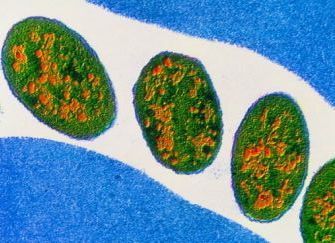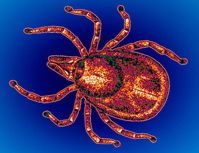 BELLEVUE, WA -⎯ Back in the 1990s, the prevailing medical wisdom was that Lyme disease is a simple, rare disorder that’s easy to avoid, difficult to acquire, simple to diagnose, and easy to treat with a 30-day course of antibiotics.
BELLEVUE, WA -⎯ Back in the 1990s, the prevailing medical wisdom was that Lyme disease is a simple, rare disorder that’s easy to avoid, difficult to acquire, simple to diagnose, and easy to treat with a 30-day course of antibiotics.
Twenty-five years of clinical practice in Eastern Long Island, NY, a hotbed of Lyme, taught Dr. Joseph Burrascano otherwise.
Speaking at the Institute for Functional Medicine’s 20th International Symposium, Dr. Burrascano said that Borrelia bergdorferi, the main culprit, is a complex bug that is impervious to antibiotics for much of its life cycle. It keeps company with a host of other nasty tick-borne pathogens, meaning that complex co-infections are the rule in Lyme disease, especially chronic long-standing cases.
No single diagnostic test is totally reliable, symptom profiles change markedly over time, and no one therapy—conventional or otherwise– works 100% of the time. In short, Lyme disease is anything but “simple and easily treated.”
It is, however, the fastest-spreading and most widely prevalent vector-borne infectious disorder in the US, and one of the most frustrating for patients, said Dr. Burrascano, a founding member of the International Lyme and Associated Diseases Society (ILADS), and author of the ILADS Lyme Diagnosis & Treatment Guidelines. He called on the clinical community to become much more “Lyme-literate.” Physicians who understand Borrelia and its pathogenic sidekicks are better able to help their patients.
A Highly Adaptive Shape-Shifter
Borrelia, “is the most complex microorganism known to science. It is highly adaptive, able to live in ticks, birds, rodents, raccoons, deer, horses, and man,” said Dr. Burrascano. A shape-shifter, it can morph between spiral, L-shaped and cystic forms in response to localized stressors. Sometimes it has a cell wall, sometimes it doesn’t, meaning that sometimes it’s more susceptible to antibiotics, sometimes less so.
Though it replicates slowly, and there may be relatively small numbers of actual organisms present in a given patient, Borrelia can wreak widespread havoc because it secretes, “huge amounts of glycoproteins, lipids and DNA, all of which are either directly toxic, immunogenic or both.”
The organism sequesters itself deep in collagen-rich tissues and fibroblasts, where it is protected from immune cells. To complicate matters, it can secrete a thick, nearly impenetrable biofilm comprised of a glycoprotein and a divalent cation matrix.
“The immune system cannot effectively attack the organism directly, but it attacks all these organism-derived signals. The immune system is highly activated but ineffective.” Over time, Borrelia destroys B-cells, T-cells, and natural killer cells, leaving the patient with a highly reactive but weak immunologic defense.
Nature’s Dirty Needles
Lyme disease is seldom the result of Borrelia alone. Ticks are “nature’s dirty needles,” said Dr. Burrascano. They carry all sorts of pathogens picked up from a wide range of birds and beasts. Borrelia takes the rap as the official “cause,” but in most cases it has one or two “accomplices” that can be just as damaging.
said Dr. Burrascano. They carry all sorts of pathogens picked up from a wide range of birds and beasts. Borrelia takes the rap as the official “cause,” but in most cases it has one or two “accomplices” that can be just as damaging.
Common co-infections include Babesia (found in 66% of Lyme patients on Long Island), Bartonella (the bacterium causing “cat scratch disease”), Ehrlichia, Mycoplasma and Chlamydia.
Ticks carrying Borrelia may also carry West Nile virus, nematodes, various species of candida, flaviviruses, and xenotropic murine leukemia virus-related virus (XMRV), a mouse retrovirus some investigators believe plays a role in chronic fatigue (though this view is strongly disputed). Epstein-Barr, cytomegalovirus, pathogenic yeasts, and drug-resistant staph have all been found in association with Lyme borreliosis.
Since Borrelia destroys B cells, T cells, and NK cells, it smoothes the road for other pathogens. “’I’ve never seen a non-responsive Lyme patient who doesn’t also have co-infections,” Dr. Burrascano told the IFM. The Borrelia-Babesia combo is particularly bad. “These patients are the sickest of the sick.” Think about and test for co-infections whenever you are working with Lyme patients (See “The Lyme Disease Rogue’s Gallery”)
The presence of other pathogens clouds the symptom profile, and renders serologic tests less reliable. It also hinders treatment, as antibiotics targeting Borrelia will not necessarily work against Babesia, Bartonella, viral pathogens, or yeasts. Learning to manage co-infections is a major key to improving outcomes.
Diagnostic Do’s & Don’t’s
“Lots of unrecognized Lyme disease is being misclassified as chronic fatigue, fibromyalgia and the like,” said Dr. Burrascano. If you rely exclusively on the Centers for Disease Control (CDC) diagnostic criteria, you’ll miss about 90% of cases, as very few patients fit the strict “classic” profile defined by CDC.
Whatever you do, don’t base your assessment on the patient’s memory of a tick bite or a “pathognomonic” erythema migrans rash. According to department of health reports from Texas and NY State, only 17% of Lyme patients recall being bitten, and only 36% recall a rash.
Lab tests may provide useful, actionable information. However, “no single test is definitive in ruling in or ruling out Lyme. This is a clinical diagnosis based on multiple lines of evidence,” he stressed (Read, “Diagnosing Lyme Disease: A Simple Point System”)
Commercial tests for Borrelia are hit-or-miss. ELISA, the most common method used by major diagnostic labs, is of little value. ELISA has a sensitivity of only 50%-70%, meaning that it returns a lot of false-positives.
False-negatives are problem too. Borrelia-derived antigens can form complexes with host antibodies; ELISA does not detect these. For that matter, neither do Western blot or other methods. These antigen-antibody complexes create a paradox: the sicker the patient is, and the longer they’ve been sick, the less likely you are to get a positive test result.
Dr. Burrascano said he generally prefers Western blot to ELISA, though the former is still far from perfect. Spinal taps are useless in most cases, as only 9% of Lyme patients show antibodies in cerebrospinal fluid. PCR-based tests have 30% sensitivity at best, making them marginally useful. In short, Western blot tests are the best way to go, though you should not rely exclusively on them to make the diagnosis.
Do you actually need positive lab findings to justify treatment? “Clinically, no,” said Dr. Burrascano, “Medicolegally, it’s a good idea.”
Useful Lab Measures
Most people with Lyme disease have normal blood counts (CBCs), sedimentation rates, and liver enzymes, so most standard blood parameters will shed little light. However, there are some useful indicators.
“Pay close attention to the CD-57 counts.” Borrelia typically destroys this subset of natural killer cells when the infection has been active for a year or more. The normal level is 180; a count under 20 indicates severe illness. Most people with chronic, longstanding disease have counts in the 20-60 range.
“These changes are not linear or gradual. The count can be low for very long periods, then suddenly jump up to normal healthy levels very fast, especially following a course of treatment. If that happens, it’s a good sign.”
Dr. Burrascano believes the CD-57 count could be used as a Lyme screening test. “Very few things besides Lyme will suppress CD-57.” He strongly recommended using the Lab Corps’ test, as it is the most well-researched.
People with low CD-57 counts are highly susceptible to mycoplasma, a destructive organism that mimics host antigens, triggering autoimmune-like reactions. Mycoplasma also generates a lot of reactive oxygen species, causing free radical damage especially in nerve tissue.
Monitor hormones carefully. Many people with longstanding Lyme show a progressive dysregulation of endocrine homeostasis. “There’s both overt and subtle endocrinopathy,” says Dr. Burrascano. Always check the thyroid, bearing in mind that Borrelia can attach to thyroid hormone receptors, so a patient will show normal serum T3 and T4, but sluggish metabolism, because the hormone can’t access the tissue receptors properly.
Treatment Tips
“You have to use antibiotics. There’s no way around that,” Dr. Burrascano stressed. Nutritional and botanical therapies, while useful, are not curative on their own. For that matter, neither are antibiotics in many cases.
Antibiotics need to be chosen intelligently and timed properly. They are most effective early in the course of the disease. The longer a patient is ill, untreated or under-treated, the less effective the antibiotics will be.
Contrary to the wishful thinking of public health officials, and the fiscal thinking of insurance plans, Borrelia is rarely eradicated with a single antibiotic course. Dr. Burrascano contends that it is, “Illogical and inappropriate to arbitrarily set limits on treatment duration.”
Borrelia grows slowly, with long latent periods during which antibiotics of any sort will be largely ineffective. These drugs only work when the organism is in growth phases. The slower the growth, the longer it takes to kill them.
The general rule is that the greater the duration of illness, the longer and more intensive the treatment needs to be. Most patients will require multiple courses of antibiotics; some will need ongoing maintenance treatment. He offered the following therapeutic tips, drawn from his own experience and exhaustive literature review:
• Optimize health before starting antibiotics: Do what you can to strengthen a patient’s vitality prior to giving antibiotics. Teach a healthy diet. Minimize allergens and toxins. Insist on smoking cessation and elimination of alcohol and recreational drugs. Encourage rest & regular exercise. If appropriate, begin a regimen to clear yeast or other parasites.
• Select antibiotics with intra- and extra-cellular activity: Borrelia lives in both ‘compartments;’ choose drugs active in body fluids as well as tissues.
• Target Borrelia’s variable morphology:
For the spirochetal walled form, use penicillins, cephalosporins, imipenim with cilastatin, or vancomycin.
For the L-shaped “spiroplast” form, use tetracycline or erythromycin. For the cyst form, metronidazole and tinidazole are best.
• Measure peak & trough levels: There’s considerable variability in the extent to which antibiotics end up in someone’s blood. It’s helpful to have a sense of a patient’s peaks & troughs
• Create “overlap” regimens to control co-pathogens: There are many potential co-infections, so there’s no “one drug kills all” option. The most common co-pathogens are Bartonella, Ehrlichia and Babesia.
For Bartonella: Fluoroquinolones, cephalosporin and rifampin are good options
For Ehrlichia: Choose fluoroquinolones, doxycycline or rifampin
For Babesia: Use a macrolide plus atovaquone
• Watch the CD-57 count: A healthy natural killer cell population indicates a healthy immune system and a strong recovery. Expect a relapse if treatment ends without a normalization of CD-57 levels.
• Encourage symptoms & temperature diaries: A patient’s self- assessment of symptoms and temperature changes can tell you a lot about treatment responsiveness.
• Avoid immunosuppressants: Steroids and other immunosuppressive drugs render pathogens more active and difficult to eradicate.
• Avoid iron & magnesium during treatment: Though healthful before and after treatment, these two minerals may impair the efficacy of antibiotics against Borrelia.
• Consider “Biofilm Busters:” Two liquid herbal extracts—Banderol, derived from the South American Otoba tree, and Samento, from a species of Cat’s Claw (Uncaria tomentosa)—can dissolve Borrelia biofilms, at least in vitro. This potentially renders the bugs more susceptible to antibiotics. Enzyme formulas like nattokinase and lumbrokinase (boluoke) may also help.
Oral vs. IV Therapy
Oral antibiotics definitely trump IV for convenience, but many patients really need the latter. Dr. Burrascano advised using IV regimens when a patient has:
• Abnormal spinal fluid
• Synovitis with high sedimentation rates
• Longstanding Lyme symptomatology (ill for more than 1 year)
• Age over 60 years
• Acute disseminated illness in the first trimester of pregnancy (intrauterine transmission is a growing concern)
• Acute carditis
• An Immunodeficiency disorder
• Prior exposure to steroids or other immunosuppressive drugs
• Not responded to appropriately targeted oral antibiotics taken for 6 weeks or more.
Dr. Burrascano challenged the idea of fixed courses with strict time durations in the context of Lyme treatment. “My best successes were with patients who were able and willing to use IV antibiotics for months to years.” That said, he acknowledged that this is impractical, both physically and fiscally, for many patients.
Pulsed & Cyclic Regimens
Pulsing an antibiotic, with 2-4 days per week on treatment, and 3-5 days off, lets you use stronger drugs at higher doses, with far less risk of toxicity, he said. For example, with a pulsed schedule, you can give ceftriaxone at 4 g/day instead of 2 g/day. Pulsing is a safer way to give highly toxic drugs like vancomycin.
You can use pulse schedules with oral and IV regimens, and with the vast majority of antibiotic types, though there are a few exceptions. Azithromycin has a long half-life, so high-dose pulsing is not appropriate. Likewise, intramuscular Bicillin should not be pulsed. Azoles require 14 days of continuous use for maximum effect, so they’re not well-suited to pulsed schedules. When using azoles, Dr. Burrascano follows a 14-days on, 14-days off schedule.
Cyclic dosing is a relatively new approach, reflecting a better understanding of Borrelia’s life cycles. The organism follows a 4-week cycle, and is only vulnerable during it’s 2-week growth phase, when transitioning from cystic to spiral forms.
The idea is to treat steadily until the patient reaches a plateau with no further improvement, and then totally stop treatment for 3-4 weeks. Toward the end of this “off” period, the patient will usually start to feel crummy again, indicating that Borrelia is actively growing and therefore vulnerable. At this point, you hit hard again with full dose treatment, long enough to induce a Herxhiemer reaction, indicating a massive kill-off of the pathogen.
This approach is definitely not a first-line strategy. It only works for patients who’ve had multiple previous treatments, and it requires a lot of trust and counseling. You need to brief the patient about what to expect, and why he or she needs to go through repeating cycles of feeling better only to be made ill again. A Herxheimer reaction can be scary, so patients need to be forewarned. Done properly, cyclic dosing can give excellent clinical results.
Nutritional & Lifestyle Support
Though important, antibiotics are only one aspect of caring for people with Lyme disease. Work with your patients to help them maintain and support overall health in as many ways as possible.
Rest is key, said Dr. Burrascano. “Do not allow patients to get overtired.” Encourage them to take breaks during the day, ideally before they hit the mid-afternoon energy slump. If it is possible, they should take Wednesdays off from work or school, and to use that day strictly for rest (not catching up on errands or unfinished work projects).
Strongly discourage patients from eating, drinking or taking anything that interferes with sleep quantity or quality—especially caffeine, other stimulants, and alcohol.
Probiotics can be helpful, especially following antibiotic therapy which can severely disrupt healthy gut flora. Probiotic-containing dairy foods such as yogurt and kefir are good additions to a patient’s diet. Dr. Burrascano recommended rotating and/or mixing different probiotic supplements and foods, to encourage gut repopulation with a wide range of beneficial organisms.
Other helpful supplements include: multivitamins with minerals; co-enzyme Q10 (provided the patient is not taking Atovaquone); Vitamin D; Essential fatty acids (krill, borage or coconut oil); transfer factors specific for Lyme disease; magnesium (during antibiotic-free periods); and methyl B-12 and B-complex vitamins. The latter are especially important for people with heavy neurologic symptoms.
Give attention to the emotional and social aspects of a patient’s life. “Lyme is a whole-system problem. People often, understandably, get into very negative attitudinal patterns when they have it.” Many will benefit from counseling and support groups.
While appropriately targeted medical therapy can make a world of difference, patients may struggle with aspects of Lyme disease throughout their lives. Dr. Burrascano believes that clinicians and patients alike need to shift their expectations somewhat.
“The goal should probably not be eradication of Borrelia, which is almost impossible. The goal should really be to facilitate healthy adaptation and tolerance so that ultimately the organisms are rendered harmless commenciles. Borrelia adapts to us; we have to adapt to it in ways that don’t lead to massive dysregulation.”







